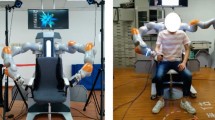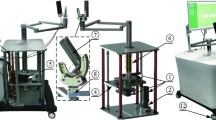Abstract
An end-traction lower extremity rehabilitation robot named ETLER is designed to meet the rehabilitation needs of patients with lower extremity dysfunction at all stages of recovery, while taking into account the ease of operation for the patient. A single robot can meet the needs of a hemiplegic patient on either side for the designed end-change structure. The robots can also be used in pairs for patients with spinal cord injuries. Meanwhile, the adjustable ankle joint limit design provides customized training programs for the ankle joint. To carry out the trajectory planning of the rehabilitation robot, kinematic analysis and control strategy modeling of the robot and human–machine system are carried out. The functionality and universality of the rehabilitation robot are verified through comparative tests.
Access this chapter
Tax calculation will be finalised at checkout
Purchases are for personal use only
Similar content being viewed by others
References
Liu Y, Xie J-X, Niu F et al (2021) Surgical intervention combined with weight-bearing walking training improves neurological recoveries in 320 patients with clinically complete spinal cord injury: a prospective self-controlled study. Neural Regen Res 16(05):820–829
Yu ZC, Teoh BY, Chong HF et al (2016) Development of low cost upper and lower extremities rehabilitation system with interactive feedback for children with movement disorders. In: 2016 IEEE EMBS conference on biomedical engineering and sciences (IECBES), pp 780–783
Gorge YAS, Sumrell R, Goetz LL (2019) Exoskeletal Assisted Rehabilitation After Spinal Cord Injury. Atlas Orthoses Assistive Devices 440–447
Redford JB (1993) Seating and wheeled mobility in the disabled elderly population. Arch Phys Med Rehabil 74(8):877
Ramanujam A, Momeni K, Husain SR et al (2018) Center of mass and postural adaptations during robotic exoskeleton-assisted walking for individuals with spinal cord injury. Wearable Robot Challenges Trends
Metrailler P, Blanchard V, Perrin I et al (2006) Improvement of rehabilitation possibilities with the MotionMakerTM. In: The First IEEE/RAS-EMBS international conference on biomedical robotics and biomechatronics, BioRob, Pisa, pp 359–364
Cho YS, Sohlberg MK, Rath J et al (2016) Exploring the psychosocial impact of Ekso Bionics technology. Arch Phys Med Rehabil 97(10):57
Pan Y-T, Lamb Z, Macievich J et al (2018) A Vibrotactile Feedback Device for Balance Rehabilitation in the EksoGT™ robotic exoskeleton. In: IEEE international conference on biomedical robotics and biomechatronics, Enschede, Netherlands, pp 569–576
Schmidt H, Werner C, Bernhardt R et al (2007) Gait rehabilitation machines based on programmable footplates. J Neuro Eng Rehabil 4(2):1–7
Schmidt H, Krüger J, Hesse S (2008) Haptic Walker—Haptic foot device for gait rehabilitation. Birkhäuser Basel, pp 501–511
Yano H, Tamefusa S, Tanaka N et al (2010) Gait rehabilitation system for stair climbing and descending. In: 2010 IEEE haptics symposium, Waltham, MA, USA, 2010, pp 393–400
Deng J, Wang P, Li M et al (2017) Structure design of active power-assist lower limb exoskeleton APAL robot. Adv Mech Eng 9(11):168781401773579
Acknowledgements
Supported by the National Key R&D Program for Intelligent Robotics Special Project (Project No. 2019YFB1312500).
Author information
Authors and Affiliations
Corresponding author
Editor information
Editors and Affiliations
Rights and permissions
Copyright information
© 2023 The Author(s), under exclusive license to Springer Nature Singapore Pte Ltd.
About this paper
Cite this paper
Bian, H., Yang, F., Sun, Z., Li, J., Ding, J., Li, S. (2023). An End-Traction Lower Extremity Rehabilitation Robot: Structural Design, Motion Analysis, and Experimental Validation. In: Liu, X. (eds) Advances in Mechanism, Machine Science and Engineering in China. CCMMS 2022. Lecture Notes in Mechanical Engineering. Springer, Singapore. https://doi.org/10.1007/978-981-19-9398-5_42
Download citation
DOI: https://doi.org/10.1007/978-981-19-9398-5_42
Published:
Publisher Name: Springer, Singapore
Print ISBN: 978-981-19-9397-8
Online ISBN: 978-981-19-9398-5
eBook Packages: EngineeringEngineering (R0)




